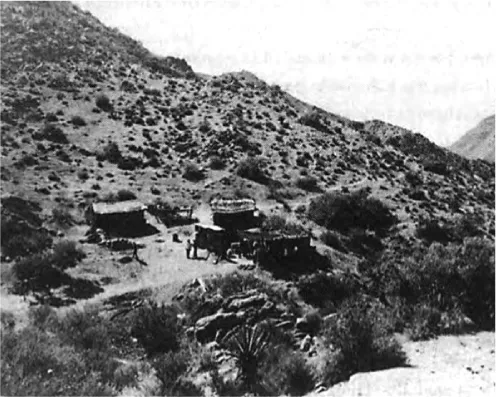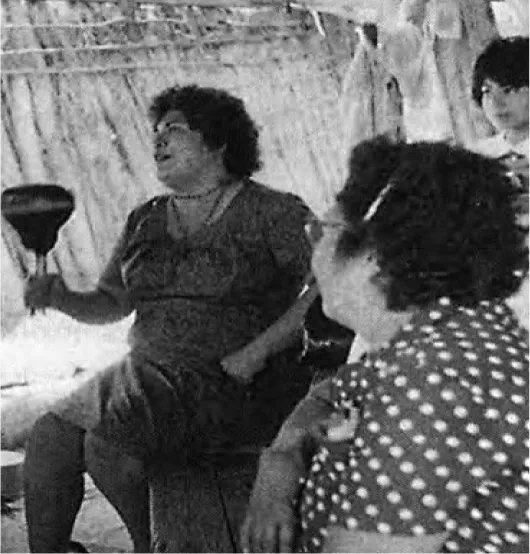![]()
linguistic glottal stop
ʔóletʔte = Coyote
So Coyote made people. He shut himself in his house while he carved people of wood. He used all kinds of wood: white oak, redwood, fir, pine, black oak, sugarpine, buckeye, maple, live-oak. He carved them like sticks and stuck them in the ground all around the house. Then he sang and danced the rest of the night.
“In the morning you will be people,” was what he sang.
Next morning they were people. Then Coyote proceeded to give them names.
“You are Bluejay, and you, you are Deer, and you, you are Dog,” he said, as he named every one.
But these people did not know how to talk. So Coyote made a big dance.
He made these people dance all night, while he was singing.
“Tomorrow, you will talk,” he said.
When they awoke the next morning, the people were all talking.
“The fleas were terrible last night,” they were saying to each other. “Those fleas nearly finished us.”
Then Coyote spoke: “Good morning.”
But the people were still talking about the fleas. Coyote was vexed by this.
—a Lake Miwok origin tale in Edward W. Gifford and Gwendoline Harris Block, Californian Indian Nights, pp. 99–100
PART I
California Languages at Work and Play: Four Portraits
THE NUMBER THREE is the “pattern number” of European and European American lore: fairy tales have three brothers or three sisters or three good fairies; a hero makes three attempts before reaching his goal. “The third time’s the charm,” we say in English, or, “Bad things come in threes.” But in most of Native California, the pattern number is four. It is the fourth try that succeeds; characters and episodes come in fours. So, in keeping with California style, this part offers four portraits of language in action—four essays that show how the use of language helps people make their way in the world of nature and society and values.
We begin at the edges of language, with an investigation of the use of song in intertribal gatherings, as a way of removing the barriers to communication across languages. Second, to demonstrate how California languages are used to have fun, I write about how storytellers represent animal talk.
While the first two essays show how people construct their social world through language, the third shows how Native Californians use language to make sense out of their physical world, though the ways in which they speak of location and direction. And finally, the last piece examines how language and thought relate to each other, and shows how the structure of language can reveal and influence the worldviews of California Indians.
Together, these four linguistic portraits give a glimpse into the culture of language in Native California.
![]()
“Now then, enough!” said Earthmaker.
“There will be songs—
there will always be songs,
and all of you will have them.”
And after that, he sang—and sang—and sang;
then he stopped singing.
“These are the songs that you human beings will have,”
he said.
And then, he sang some other songs;
singing some other songs, he started off.
He went a long way
until he finally came to the middle of the world.
When he got that far,
he sat down and stayed there.
But, telling about the world,
Meadowlark sang very beautifully.
He was the first being created,
the first being to go across the meadows.
He was the being who saw the dry land,
very beautiful;
singing from the beginning—
a being who sang songs.
—William F. Shipley, The Maidu Indian Myths and Stories of Hanc’ibyjim, pp. 29–30
CHAPTER TWO
Song
Overcoming the Language Barrier
IN CALIFORNIA, THE BORDER between the United States and Mexico is clearly visible in satellite photographs. You can see a startling boundary line between the green crops of Imperial County, watered by the mighty canals that empty the Colorado River, and the brown fields of Baja California, where, due to the barriers of international politics, the canals never reach. On the ground, barbed wire fences, metal walls, and armed guards make the location of the border obvious.
From the point of view of Native America, this boundary is arbitrary and alien. It clearly defines the division between the dominance of Anglo and Hispanic peoples, and the English and Spanish languages, but it simply runs right through the middle of American Indian linguistic and political divisions. Relatives are separated from each other by that border. The Kumeyaay language, which is spoken by communities both north and south of the border, is officially called Diegueño because they are the people who were at Mission San Diego back when California was part of Mexico and the border did not exist. It is not possible to write about the Native languages of California and ignore Baja California.
Once, some decades ago, I went with a group of Kumeyaays and other friends from San Diego to visit the Kiliwa people in Baja California. The Kumeyaay group included such illustrious people as Rosalie Pinto, a singer and medicine woman, and Delfina Cuero, narrator of the book Delfina Cuero: Her Autobiography (Shipek 1991). Rosalie was the motivating force for this trip. Energetic and intense, full of intellectual curiosity, she wanted to visit the Kiliwas because she had heard they spoke a language related to Kumeyaay, and she was interested in their history of isolation and traditionalism.
The Kiliwas live in the Arroyo León, located in the foothills south of Valle Trinidad in the heart of northern Baja. Nowadays, the paved peninsular highway goes through Valle Trinidad, cutting away its previous solitude. But at the time of our visit, the Kiliwas were very isolated, both geographically and socially. Their dealings with Mexican institutions had not been particularly happy, and it was a constant battle to keep their land base from being eroded by the surrounding interests. During the Mexican Revolution (1910–20), Kiliwa men were known as great fighters, but over half died in a massacre in 1911, and those who remained fought with a radical fringe group that never gained any power in the new government, leaving the Kiliwa families with neither recognition nor reparation. Embittered, and ignored by the rest of Baja California, the tribe was alienated both socially and economically from the Mexican mainstream.
Some people left to work in the towns, but those who stayed in the traditional community lived almost completely without money—they built thatch homes, depended largely on wild foods, and, for the most part, spoke no Spanish. At the time of our visit, there were only nineteen Kiliwas in Arroyo León, and only a few spoke Spanish fluently. From the vantage point of our overpopulated cities here on the other side of the border, it boggles the imagination to think what it must be like to have only eighteen other people in one’s entire social universe to communicate with.
But wait. Did I say communicate? One of the many things I learned on that wonderful journey was how many different ways there are to communicate. And what I learned most stunningly was how important music is as a form of communication.
The Kiliwa village in Arroyo León, in the early 1970s. Photo courtesy of Margaret Langdon.
Song is an ancient form of intertribal communication, here between Kiliwa and Kumeyaay people. Photo courtesy of Margaret Langdon.
Speaking presented an interesting translation problem. The visiting Kumeyaays, from north of the border, knew English but no Spanish, and none of the Kiliwas knew English. Some of the Kiliwas and one or two of the English speakers spoke some Spanish. When the Kumeyaay elders wished to say something, they spoke in the Kumeyaay tongue, which one of the younger Kumeyaays translated into English; someone else then translated that into Spanish, and finally one of the Kiliwas who understood Spanish would complete the translation ...





